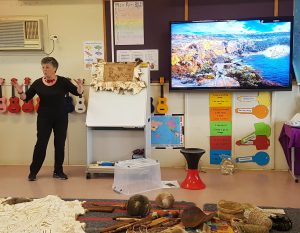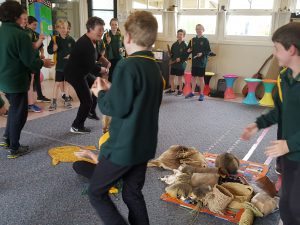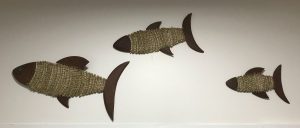Aunty Michelle passes Boandik knowledge on to local students
Martu karu! (G’day)
In July of this year I attended the book launch of Annie’s Story – Growing up strong on Boandik country, a children’s book based on the life local Boandik girl Annie Brice in the mid-1800s. Annie was author Michelle Jacquelin-Furr’s great-grandmother and grew up around Penola in a time of increasing European settlement and saw lots of changes and restrictions to Aboriginal peoples’ lifestyles during her lifetime.
The book launch was an inspiring well-attended event with Aunty Michelle’s daughter and grand-daughter both playing significant parts in the evening, indicating the family’s passion for and connection to their Boandik culture. Each page of Annie’s Story has a few paragraphs in both English and Bunganditj (Boandik language) and beautiful photographs taken throughout the South East; you can also use your phone to scan the QR codes to hear Bunganditj being spoken! More info on the book can be found here.
I remember that my schooling here in the South East did not include much in the way of Aboriginal education (partly due to lack of local resources) so I got in touch with Aunty Michelle to discuss with her any possible involvement she could have in the biodiversity education program which NGT delivers to three local schools on behalf of ForestrySA. She shared my enthusiasm and set about creating a roughly one-hour program covering many aspects of Boandik life.
And so it came to be that in the past couple of weeks Aunty Michelle and I spent a day at Newbery Park and Glenburnie Primary Schools with students ranging from Reception to Year 7 learning about Boandik culture. Aunty Michelle welcomed each class in Bunganditj, a language which has been sleeping and is now undergoing a revival. Every session was different with Aunty Michelle tailoring the content to the age and interests of the audience. We learnt Bunganditj greetings and other words, about Annie’s life, Boandik customs, and the many uses for brushtail possums including Aunty Michelle’s possum skin cloak (kuramu tutu). You can read more about the revival of Bunganditj language and the possum skin cloak here. Staff and students alike enjoyed this insight into our history, and there are many available avenues for follow up by teachers in later classes.
The final activity with each group was to begin learning to weave. Aunty Michelle taught this ancient skill with a contemporary twist – we used raffia and modern needles to begin creating art installations. While traditionally Boandik people have woven baskets, dilly bags, and eel traps, we began working on woven fish. Classes will continue working on their fish and once complete they will hopefully be displayed in each school.
As far as I can see, there can only be positive outcomes to increasing our understanding of Aboriginal cultures and in particular our local Country, so I’d like to give a huge dudu (thank you) to Aunty Michelle for sharing her knowledge with us!
Wuwu! (Goodbye)
This activity formed part of ForestySA’s biodiversity schools program.




